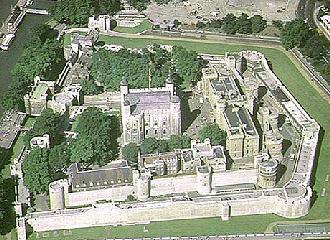 |
 |

Tower of London
[Tuesday - 11/01/94] An amazing and eventful history began in 1067, when the Tower of London was no more than a simple enclosure constructed by William the Conqueror in the south-eastern corner of the old Roman City.
This magnificent spectacle, recognised the world over as part of the London skyline, was the original White Tower, the earliest part of the castle begun by William and completed towards the end of the 11th century by his son, Rufus.
Practically square in design, the three-storey Tower dominated the site from all angles, and has barely altered to this day. During the 12th century only minor building works and some fortification to the south side of the site was carried out, but in the next century a dramatic conversion was instigated by Henry III, to create a resplendent palace and fortress. Much of the inner curtain wall was erected during this period, along with the majority of its thirteen towers, and several domestic buildings, although most of these have since disappeared. The King had a passion for Gothic architecture, and this remains very much in evidence today. It was at this time that the White Tower acquired its name, having been completely 'whitewashed', both inside and out.
With a continuing enthusiasm, his son, Edward I, completed the outer curtain wall with its six flanking towers, and built a new entrance from the city through Lion Gate on Tower Hill. This entrance passing through a series of drawbridges at Lion Tower, Middle Tower and Byward Tower, is how the public access the Tower today. The site was also accessible from the River Thames through St. Thomas Gate, at the bottom of the tower, named after St. Thomas Becket.
Work on such a major scale has not been carried out since the 13th century, and the present layout of the Tower of London is a fairly accurate representation of how it would have appeared in Edward's time. Minor additions and improvements have been made within the inner bailey, such as the Queen’s House during the reign of Henry VIII, the New Armouries of the 17th and 18th centuries, and the Waterloo Barracks and Fusiliers Museum during the 19th/20th centuries.
Throughout history, the Tower of London has played many significant roles, from a Norman castle, to a wondrous palace, and from a grim medieval prison for those awaiting a gruesome death, to a famous treasure house. In this latter role as an important stronghold, the Tower has housed the Crown Jewels for several centuries, and exhibits a fine collection of armour. At various times the Tower has also held the Royal Mint, the Royal Menagerie (until the animals were moved to Regents Park), and public records.
The Tower of London exhibits a magnitude and splendour beyond description, resulting from its rich and diverse history spanning 1100 years. Coupled with the fact that it has been regularly maintained and restored without any substantial structural alterations, it surely is a key element in the heritage of England’s capital city.
|
Last modified on Wednesday, November 26, 2008 URL: http://www.housecorvus.org/tol.htm Copyright © 2000-09 House Corvus. All rights reserved. Design and hosting by Bran Trefonnen. | |